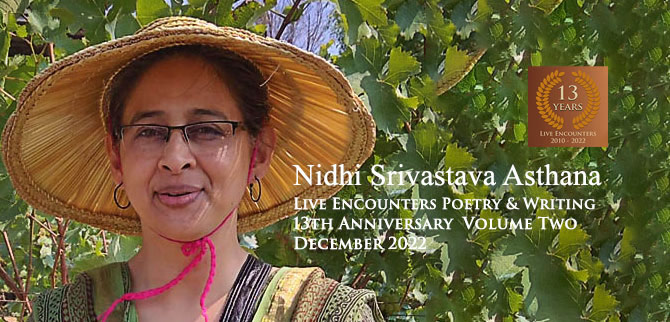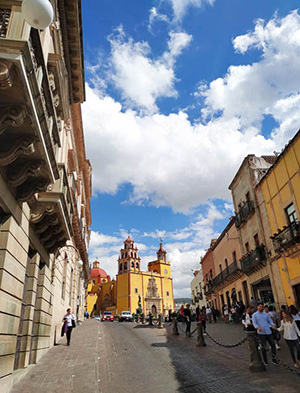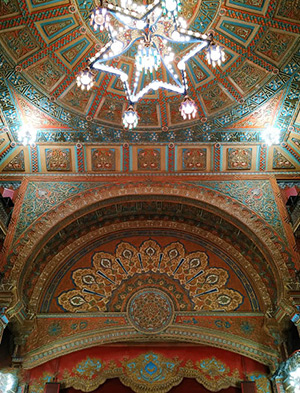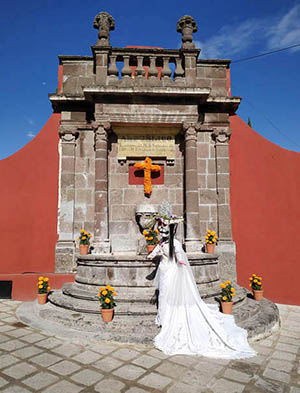
Download PDF Here 13th Anniversary
Live Encounters Poetry & Writing Volume Two December 2022.
When a Man Loves a Woman, short story by Nidhi Srivastava Asthana.

Being deep in a pedestrian zone, my small hotel was surrounded by narrow lanes flanked by homes. So, traffic noises were replaced by sounds with a human touch: people running up and down steps and side lanes, a hawker calling out the names of what he had on offer, families laughing, a mother and her son descending some steps in sync with loud counting to make a game of it…
Mornings were especially pleasant because, like all places in the mountains, Guanajuato amplified sounds. It was fabulous to wake up to cocks crowing and church bells ringing somewhere. The plazas there were much smaller than I had seen in other historical centres in Mexican cities. There was not much flat, open land to go around. The various squares were essential to life there, and the goings-on in the plazas were the closest I was going to get to seeing how the locals lived.
Every morning those commons came alive with people having breakfast. The restaurants catering to tourists arranged chairs outdoors and got their hot cakes act together. But the people who belonged to the city, especially in the smaller of the small courts, seemed partial to corn based breakfasts with steam rising from the thermocol glasses they raised to their lips. Hawkers set up stalls or open baskets full of freshly baked goodies. Some of them doubled as newspaper agents.
Later on in the day I saw children chasing pigeons in Plazuela San Fernando. Was this the apogee of activity there? Or was the dog chasing two girls as a sport the highlight? One of the kids climbed up a tiny tree to safety; she was undecided between fun and fear. A couple of old men sat around on benches looking completely relaxed and moved every once in a while only to feed the pigeons. Till it was time to earn something. Which is when they would get up, revealing that they were actually especially dressed for their profession, and sing in one of the restaurants surrounding the plaza. A few numbers … and it was time to relax again. Not a bad life at all!
The most insipid seemed to be the square closest to my hotel. It had its fountain and ornate wrought iron benches. But it also had very incongruous stadium style seating stalls in one corner, which left me wondering. Till the time I crossed the plaza one afternoon. One of the buildings flanking it had always proclaimed that it was an escuela primaria. But what this implied became apparent only during my last afternoon in Guanajuato as I walked back to my room to pack my suitcase. Happy and eager little people ran into the safety of the open court for their recess. An apron clad assistant watched over them from the shadows of the school door. The vendor of breakfasts, who had set up her stall earlier on a trestle table, finally became active.
The children got busy paying serious attention to the business of eating as they sat down on the parapet circling the fountain, on the benches or on the ugly stadium-stand. I did not see even one boy fighting, pushing or being violent, which used to be the prime occupation during recess of the boys that I went to school with. So, either humankind had evolved in the last 30 years or Mexican boys were little angels. I saw the beauty of this plaza as a safe haven for these remarkably well behaved children. I slowed my pace a little to savour the innocence in the air.
The Museo del Pueblo de Guanajuato was housed in the home of a former silver baron; it was interesting without being too pedantic. In the three halls upstairs, I found caretakers or assistants, spanning three generations, doing work that I imagined to be humdrum. Yet, I was fascinated by the differences in their attitudes to it. Middle Age had acquiesced in the monotony of life while managing to maintain a business like demeanour.
Youth hadn’t realised how long 40 years of sameness would be; meanwhile, his earphones were pleasantly relaying music to his ears. The pretty American women crossing the courtyard were not a poor distraction, either. Only Old Age moved with considerable effort, leaning on a cane, to check whether I had seen an adjoining gallery. And to point out the portrait of the wife of the famous local painter: Hermenegildo Bustos. Another painting by Hermenegildo was a family portrait with the parents seated on either side of their daughter with their arms around her shoulders. The girl, Bustos’s daughter, had actually already passed away when he had painted the picture. I would have never got to know this if Old Age had not spoken. Thankfully, he was of a generation that could not imagine not reaching out to people.

That Guanajuato was a university town was obvious from the dazzling ₋ if you got taken in ₋ or garish ₋ if you didn’t ₋ façade of the University building. But more so from the number of youngsters walking in the streets or patronising the obviously cheaper food joints tucked into the back lanes near the University. A book exhibition was housed in a canvas stall winding down, centipede-like, the slope of a lane.
And an incredibly large number of people seemed to be having conversations with ‘maestros’ or ‘maestros’ on their cell phones. How could I tell? The magnificent Mexican obsession with titles! I had known no other country where an accountant was addressed very respectfully as an accountant: not as Señor Perez but Contador Perez!
I met two young students with a sense of humour. Holding small paper cups of very bitter poisonous coffee and sucking hungrily at their cigarettes, the young ladies laughingly pointed out to me the irony of being yoga students. I had decided to go to a rather out of the way place called Cristo Rey: a more than 20 meter high bronze statue of Jesus atop a mountain said to be at the exact geographical centre of Mexico, making it ‘Jesus in the heart of the country’ kind of apt. I requested the girls to help me figure out where the bus stop was. They first gleefully pointed out the bus I could take if I just happened to want to visit someone in the local jail. They did eventually manage, after the necessary consultations, to point out the correct bus stop if I had only Jesus in mind.
It was a teeth rattling ride over unpaved roads in what eventually proved to be pouring rain. But the driver and the conductor ₋ or both ₋ had a fantastic taste in music that added a lot of Latin American flavour to the journey. Since the windows soon got misted over and the sights were blocked out, my ears took over the task of keeping me amused.
As I stood facing Christ, my shoes were full of water and the hems of my jeans soaked through despite the umbrella that I ineffectually held over my head. A shivering moth on the wet floor of the covered arcade seemed to share my discomfort. We were the only two non-microscopic creatures in Christ’s presence. In the chilly and foggy air, all I could see were the outlines of Christ as a huge apparition hovering over us. I rode back in the same bus. More good music. So, the whole trip had never really stood the chance of being a spiritual experience.
The house that Diego Rivera and his twin, who died as a child, were born in is a museum that was inaugurated because of Diego’s son’s vision and interest in the project. This made me wonder about the probable struggle to accept parents who behaved like teenagers in their adult years and to share their foibles with the world: the 11 am screening of the documentary based on Diego’s life was not eulogistic but very honest and balanced about the scandalous aspects of his life.
A victim of its success as a centre of silver mining, commerce and agriculture, Guanajuato drew people from other parts of Mexico as workers: at the cost of its natural ambience. The Valenciana mines once added hugely to the wealth of Spain. I had really looked forward to ‘going down a mine’. What we did descend was a mine strictly for tourists, which reached 50 metres below the surface of the earth; while a real mineshaft can go down to even 500.
Our climb down was using a staircase with handlebars down the sides. It ended no sooner had it begun. The warning at the entrance pointing out the risks to ‘the aged, unfit and faint-hearted’ seemed like a joke in hindsight, as did the helmets we had donned with great expectations. But I did get a sense of how tough life was, and had always been, for those who mined for a living. Not surprisingly, there was a shrine to Saint Ramon near the mouth of the entrance. Of course, we heard about the tough and short lives of the diggers of yore. Miners of today don’t earn very much for their pains, either.
I was part of a guided tour, and the group had at least three couples of tercer edad who got suitably intimidated by the cautionary advice and decided against climbing down. A pity because they were lively and really young at heart. I was proud of the fact that I was ‘getting’ the jokes of a very local flavour that our guide was cracking: of the mother-in-law and alcohol variety. It really made me belong. There was another couple that looked Mexican but spoke English with an American twang. Throughout the trip, the wife would translate in rapid fire English what the guide had just explained in Spanish; even though this helped me fill in a few blanks as well, I felt so superior to the Latino man from Los Angeles who spoke no Spanish.
Our group was taken to a silver jewellery store and a traditional sweets store. We had our priorities right. Everyone became really animated looking at the food: even the Japanese who had had few opportunities for showing animation because just one of the four spoke Spanish. The other three had only had a chance to offer themselves as volunteers in the Inquisition Tortures Museum of Valenciana because that role required no speaking. They had just needed to be good at pretending to be tortured to death in one of the fancy contraptions while our group bid them goodbye. The guide at this private establishment had reminded us after the tour that we could offer him tips if we wished. If not, he did have all those instruments of torture at hand!
Since I had left my salwar suits at home, the guide was one of the very few Mexicans to guess correctly that I was from India. He told me that he had watched My Name is Khan and loved it. I confess that the movie’s philosophy of tolerance and respect for religious diversity had strongly resonated with me. Yet, had he said that he hadn’t liked it, I would have happily blurted out that we tortured people in India by showing them My Name is Khan: the embarrassingly poorly-told story that it was. I just kept silent, marvelling at the phenomenon of a Mexican having watched a Bollywood movie in Mexico.
For a statue that the entire city literally looked up to, I found the Pípila to be distastefully lumpy and ugly. Nor did I care for that particular shade of pink. During the 1810 independence movement, the Spanish powers that be and their supporters locked themselves into the Alhóndiga, a granary, for safety from Hiladgo’s forces baying for their blood; it was a solid and severe building that now housed a museum. Pípila had been a miner and is said to have worn a shield on his back to dodge the Spaniards’ bullets and set fire to the gates of the Alhóndiga: making the colonised people’s victory possible. In an interesting twist, the local hero’s very existence had also been contested!
I chose not to ride up to the pink statue in a bus or the funicular. I walked up a series of steps and narrow lanes that wound between the houses painted in all kinds of fantastic bright colours. The walls of the houses were often sprayed with graffiti, and the landings or places for getting one’s breath back were marked by plenty of garbage.
The climb was neither too arduous nor too long, but a climber still needed some compensation. This came in the form of two human statues fully coated with shiny paint – including their attire and helmets. The two young men as miners had achieved excellence not just in their makeup but also in the perfect stillness they achieved. The one bathed in gold moved just once in robotic jerks to amuse a child. I was more than happy to ignore the pink monstrosity to concentrate on the human figurines instead.
You couldn’t blame a middle aged woman for feeling flattered when a man left a poem titled ‘When a Man Loves a Woman’ on her table just as she was easing herself into a chair at a restaurant for a longed for meal after a rich but tiring day of visiting tourist sites and seeing museums. Well, the man simply left a photocopy ₋ a single sheet of paper ₋ on my table and disappeared into the crowd at the triangular plaza at the Jardín de la Unión before I could register him as more than a receding blur. A grill separated my table at the restaurant from the common, and it was easily accessible to anyone from the pedestrian area.
Suitably fortified after a banana and kiwi smoothie, but still mystified, I picked up the sheet of paper. And read the poem slowly and carefully: savouring not just the words but the sensation of being able to understand it. There were some accents missing in the text; a fact I gave myself a pat on the back for noticing. It was also time for second thoughts. Was this a way to rub salt in the wounds of a lone (and lonely?) woman travelling and eating alone? The waiter placed a plate of enchiladas on my table and gave me something else to think about.
‘Did you read it?’ demanded someone from the other side of the grill, but almost standing at my elbow. He had stolen up, to where he stood, absolutely noiselessly. The voice belonged to a man sporting a Brad Pitt hair do that sat a bit incongruously on his slightly wrinkled and definitely-not-youthful face. ‘Sí’. ‘Well, I wrote it,’ he said with such a swagger that his locks swayed. I took an instant dislike to this man who was very obviously putting on artsy and superior airs. It took me just two seconds to feel a deep disappointment.

The poem had not been bad at all. Its biggest virtue, to my mind, had been its comprehensibility. But that aside, it spoke of a no doubt clichéd truth, but a truth all the same: the pointlessness of life without love. If only this boor hadn’t written it (had he?)! ‘What did you think?’ he demanded.
The only thing that I was thinking at that moment was that I did not wish to speak with him anymore. So, the simplest, and not totally untrue, way out was to claim that my Spanish was rather limited. ‘But did you understand it?’ came the aggressive enquiry. ‘Más o menos’. It’s almost as if he was not interested in the answer. ‘Well, if you want to keep it, you’ll have to pay,’ he said in a self-satisfied way.
At this point, I had probably started looking put off. ‘Do you want to keep it?’ he said in a tone of utter disbelief. Who would be stupid enough not to keep the world’s greatest poem as their most treasured possession? At which point, going totally against my basic grain while resolving simultaneously to never feel guilty later about discouraging a creative being (him??!!), I uttered a firm no while handing the sheet of paper back calmly and started eating.
‘When a man loves a woman, he writes poems for her for free,’ I thought to change my mood and to amuse myself.
© Nidhi Srivastava Asthana
Nidhi Srivastava Asthana worked as an instructional designer in the computer software industry in India, loved sharing historical stories with her students in Myanmar and Thailand, lived in the USA as a student and has been an accompanying spouse to her peripatetic husband in five countries. Her stories have appeared in ‘Manushi’ and ‘Literally Stories’ and another is due to be published by the Sahitya Academy in ‘Indian Literature’. Her essays have been published by Kitaab.org, ‘India Currents’ and liveencounters.net. Similarities and differences between cultures, especially linguistic, have always fascinated her. Here are links to Nidhi’s writings available online:
Here are links to Nidhi’s writings available online:
Personal and Travel Essays
https://liveencounters.net/wp-content/uploads/2021/11/LE-Poetry-Writing-Vol-3-Dec-2021.pdf — Page 33
https://indiacurrents.com/a-village-on-the-tonle-sap/
https://kitaab.org/2022/02/08/essay-language-chutney-by-nidhi-srivastava-asthana/
Short Stories
https://literallystories2014.com/asthana-nidhi-srivastava/
http://manushi-india.org/pdfs_issues/PDF%20142/09%20%20the%20vidya%20tree%2041-42.pdf
https://kitaab.org/2022/05/22/short-story-a-tale-of-two-mithais-by-nidhi-srivastava-asthana/

